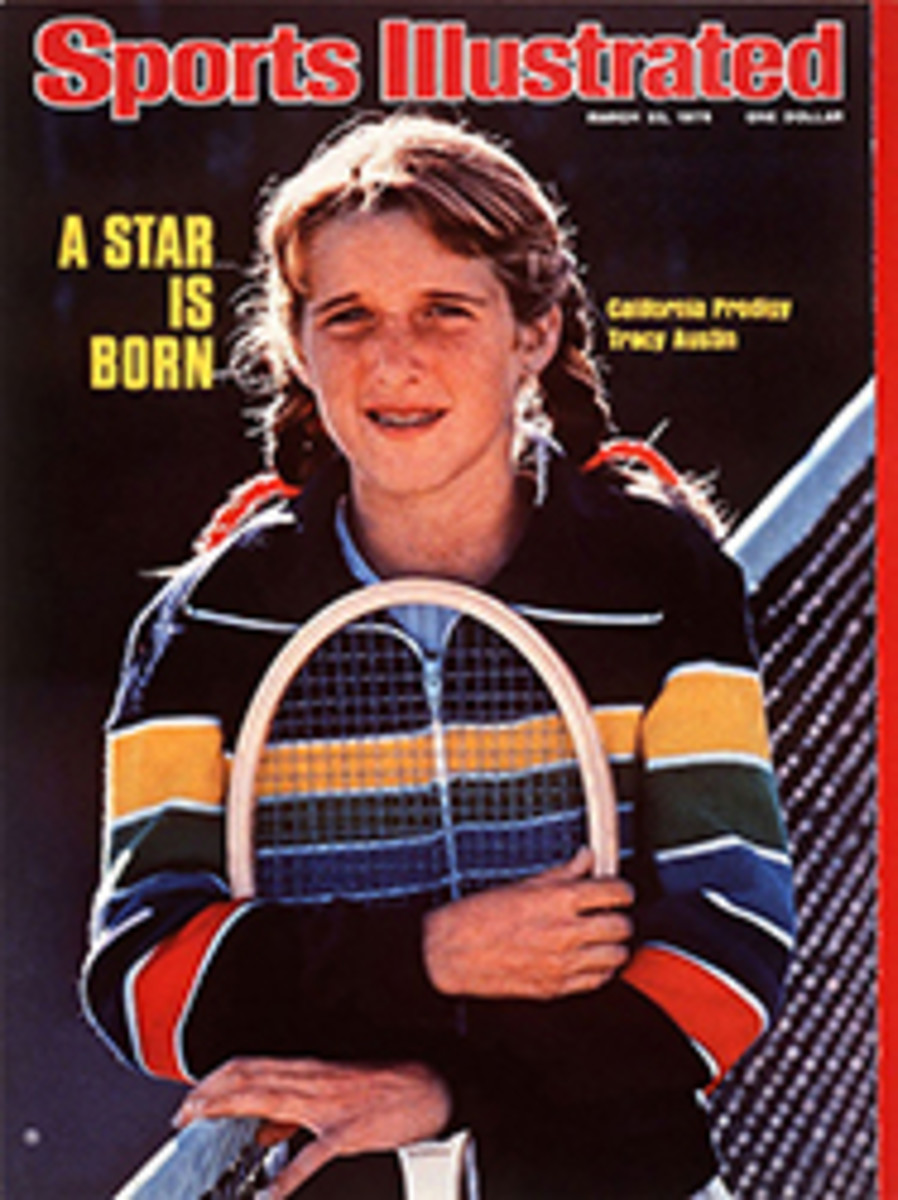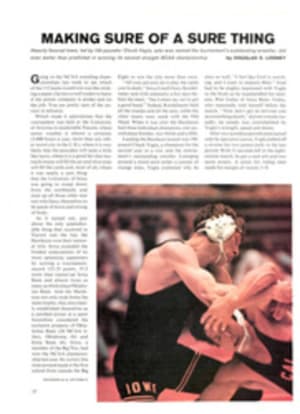
'In my strategy, I have given up sinking'
An offshore racing powerboat, by simplest definition, is a specialized hull that is usually overpowered and constantly beset by gremlins. By equally simple definition, the drivers of such craft are men so accustomed to frustration that they are willing to pound along over the cruel, cruel sea for more than 150 miles in every race knowing they have about an even chance of making it to the finish line. Many of the finest victories in offshore racing are Pyrrhic. The usual first-place prize is about seven grand, which is enough to send the winner on to the next race.
The hazards of the game make some contenders mad enough to quit. Others get even madder and keep coming back for more. It is a queer contagion, not easily contracted but indiscriminate, taking the young and the old, and rarely afflicting any two victims the same way. The defending national champion, Sandy Satullo of Cleveland, started offshore racing four years ago at the age of 50. He won his first four races—an unparalleled debut for a rookie—before the usual griefs started coming his way. He failed to finish his fifth race because of a broken stern drive and almost sank his boat in the sixth. The following year, while cavorting for a TV cameraman, he did sink it. After another struggling year, he took a more conservative stance in 1975, kept his foot off the fire wall at times, and won the title. So where is Satullo this year? With three of the nine races that count for the title already run, he is a poor seventh in the standings, but still gung-ho.
For an idea of how the sport can affect the youth of America, there is the contrasting case of Bill MacDonald of Miami, who took up offshore racing five years ago at the age of 20. Although none of his grief was out of the ordinary, for three hard years he suffered like Job. As he describes it, "I kept breaking crankshafts and rods, burning pistons and dropping valves." The letters "DNF" (for "did not finish") virtually became his middle initials. After getting 14 DNFs in 20 races and having one hull all but destroyed by a gas truck while being towed back from California at the end of 1973, he gave up the sport. So where is MacDonald now? He is back at it, promising himself he will give it up for good next year.
The offshore career of Preston Henn, a 45-year-old proprietor of drive-in theaters in Florida, began uniquely with a disaster for which no gremlin can take credit. In 1974, while the Magnum hull in which he planned to make his racing debut hung on davits at his dock, Henn inserted a hose in the engine cooling system to flush it out, left the hose running and forgot he had. Three days later, while he was away on a trip, a neighbor telephoned him to say his boat had broken off its davits and was on the bottom. In Henn's first race, the 1974 Bahamas 500, the salvaged boat spun out and sank under him 30 miles out in the Gulf Stream. After a tanker rescued him and his crew from their inflatable raft and a helicopter ferried them to shore, Henn promised his wife he would never race again. "I bought a 38-foot Bertram prototype for pleasure," he says, "but I knew in the back of my evil mind I would race it."
Shortly thereafter he took second in class in the Miami-Nassau race, barely getting to the dock without sinking. Subsequently, without any assist from him, the Bertram, like its predecessor, fell from its davits and sank at the dock. A year later in the Point Pleasant race off New Jersey, Henn had to beach the boat within sight of the finish, because it was taking on so much water. What has Henn done since then? He has bought a brand new 38-foot Bertram, which he calls Streaker after the adult movies he shows at some of his drive-ins. So far on the 1976 championship trail Streaker is holding together fine, but Henn is coming slightly apart. In the rough Key West race, where he took third-place points, he broke his nose. Coming in second in the Grand Prix del Rey in California last month, he sprained an ankle. "In my race strategy this year I have given up sinking," he says. "Now it's straight from the finish line to the doctor's office."
Because of the cost, offshore racing will never grow in leaps and bounds, but it will survive as long as there are men as badly bitten by the bug as Satullo, MacDonald and Henn. The fields in the three races run to date for the 1976 national title have been without question the best ever. While the title is a prime aim of most drivers, there are some with further motivation. For one, there is Arnold Glass, the two-time Australian champion, who is anxious to have a go at Yank competition. For another, there is Peter Rothschild, who 10 years ago won the U.S. title and came back in the third race this year largely to prove the worth of a modified, turbo-charged Chevy engine marketed by himself and its modifier, Chuck Daigh, under the label TCX. For another, there is Betty Cook, the only girl in the game, who in her high school days used to run slalom on bear-trap bindings between the gravestones of a sloping cemetery in Glens Falls, N. Y. Cook's object is not to prove the worth of women drivers but to test the capabilities of a tunnel hull configuration in open water. "Everybody in this sport knows more about it than I do," she says. "I do what I'm told. I'm a monkey at the wheel. If I have any advantage at all, it's that I don't have a male ego to feed." Joel Halpern, a New York investment builder and contractor who formerly got his knocks playing semipro hockey and racing modified and late-model stock cars, is intent on proving that a prototype Cobra hull will at least keep Bertram and Cigarette boats from dominating the offshore game.
In the races off Key West and Marina del Rey, most of the legs were run in seas five feet or higher. The point leader after these events was the most battered driver of the lot, 63-year-old Bob Nordskog, a manufacturer of airplane galley equipment who is better known in Southern California for the honors he has won and the bones he has broken racing all manner of boats, some of which were about as hydrodynamically sound as a crated piano.
The third race of the season, run last Saturday at Newport Beach, Calif., was called the Bushmills Grand Prix because it was sponsored by the Irish whiskey of that name. Bushmills not only provided the $10,000 prize money but also an Irish stew dinner and a fifth of whiskey to each driver—but none of the luck of the Irish. On the course misfortune cropped up as usual. As is their custom, in the Bushmills race the gremlins started going to work well before the starting gun. Betty Cook's crew could not get the steering of her tunnel hull properly fixed in time, so she was obliged to drive an orthodox V-bottom boat. On the eve of the race the wind blew, threatening another gut-busting contest like that at Key West, but by dawn it had dropped to nothing and barely picked up with the sun, so that the waves on any leg rarely exceeded a foot. In such a relatively slick sea Cook might have smoked off the whole gang in her tunnel hull.
In the Grand Prix del Rey, Arnold Glass, the Aussie, had had the most freakish luck. He hit a whale, warped a propeller and was lucky to finish seventh. Five minutes before the start of the Bushmills a large gray whale, some 50 feet in length, surfaced about half a mile in front of the line as if looking for a return engagement. Glass, alas, had blown an engine, and never made it across.
When seas are small, the ride is easier, speeds go up and most of the grief derives from overworked engines and drive chains. In the Bushmills 10 of 16 starters finished, but only half a dozen of them with both engines coughing out their best. In the first third of the 185-mile race three boats died and one swapped ends, throwing its crew overboard. Satullo led handsomely and briefly near the start, but lost his power after 105 miles. Peter Rothschild aptly proved the potential of his TCX engine. He led for more than 70 miles, but by the finish he was limping. Bill MacDonald finished eighth to keep his record for 1976 clean of DNFs. Throughout the first 135 miles Bob Nordskog was never worse than fifth, but in the end he was lucky to finish seventh with a distributor badly out of whack. The race was won by the new kid on the block, the Benihana restaurateur Rocky Aoki (SI, March 1), who in his brief offshore career has bounced between first place and DNF with nary a stop between. In his debut in last year's Miami-Nassau race he won in record time. In the Key West race, turning too sharply in a leap off a wave, he came down hard on the port quarter, almost busting up the boat for good. In the Marina del Rey race he broke a stern drive. On the longest leg of the Bushmills, southward along the coast, he hugged the shore inside the kelp, adding perhaps half a mile to his course to get even calmer water than the lakelike seas the others were pounding across.
Aoki and his throttleman Hal Smith resisted the temptation to go full bore and, with power to spare, took the lead from the flagging Rothschild 30 miles from the finish. With 10 miles to go Aoki had a comfortable 45-second lead on the now unsinkable Preston Henn. But in the last half mile what had been comfortable suddenly became a squeaker. Aoki lost power in one engine and crossed the line with Henn closing 20 mph faster.
Because he did so poorly Bob Nordskog dropped from first in title points to third behind Joel Halpern and Preston Henn. "So it's a close race between us three," Nordskog said. "That's how these things should be."
PHOTO
WINNER AOKI GIVES THE FLAG A WHIRL
PHOTO
CHAMP SATULLO BOOMED, THEN BUSTED

